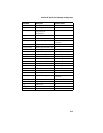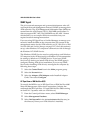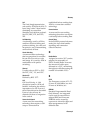
Glossary
Glossary-5
Cell
The fixed-length transmission
unit used by ATM. Each cell is 53
bytes long with a 5-byte header
containing its connection
identifier and a 48-byte payload.
See CLP, HEC, PTI, and VCI/
VPI.
Cell-Switching
A technology used by ATM to
combine circuit-switching and
packet-switching, for a fast and
inexpensive way of transmitting
various kinds of data.
Circuit-Switching
A communication technology
that is appropriate for constant
bit rate services such as voice
and image. It is used by ATM in
combination with packet-
switching.
Channel
Usually refers to PVC or SVC.
See PVC, SVC, VC, and VCC.
Classical IP
Defined by RFC 1577.
CLP
Cell Loss Priority. A 1-bit
descriptor found in ATM cell
headers, indicating the relative
importance of a cell. If set to 0,
the cell should not be discarded.
If set to 1 the cell may be
discarded if there is congestion
in the switch.
Connection-Oriented
A term used for networking
technology that requires a call-
setup or connection be
established before sending data.
ATM is a connection-oriented
technology.
Connectionless
A term used for networking
technology that does not require
a call-setup before sending data.
Control Plane
In the B-ISDN protocol reference
model, the layer that handles
signalling and connection
control functions.
D
Double Buffer
Assigned to receive VCCs on the
adapter for reassembly of
PDUs. Double Buffer increases
the amount of buffer space
allocated to a VCC, maximizing
throughput while decreasing the
number of available VCCs.
E
E1/E3
The European version of T1/T3.
E1 runs at 2.048 Mbits/sec and
E3 runs at 34 Mbits/sec.
EPROM
Erasable Programmable Read
Only Memory. An integrated
circuit used to store the host
adapter BIOS and firmware.
EPROMs can be erased by
exposure to ultraviolet light and
then reprogrammed with
different data.


















